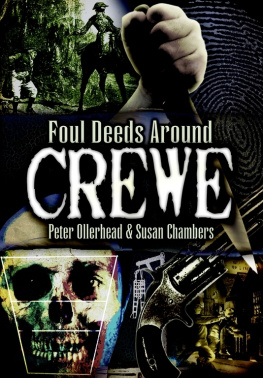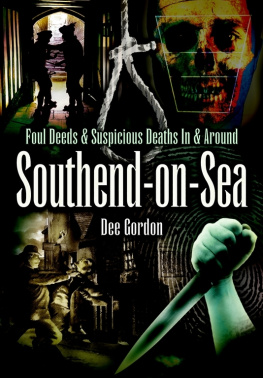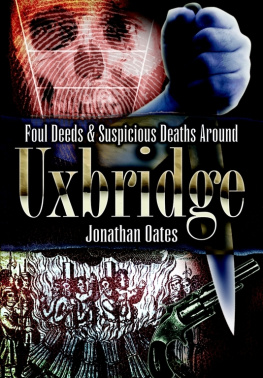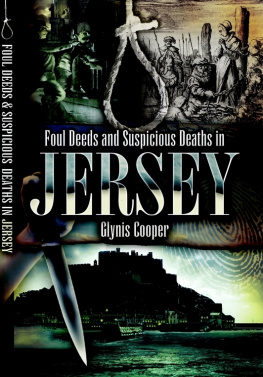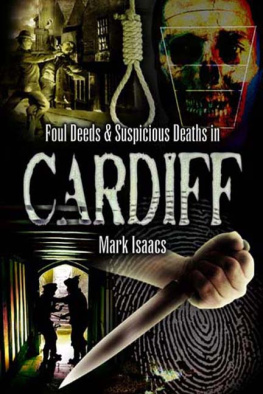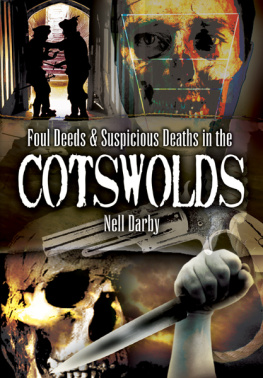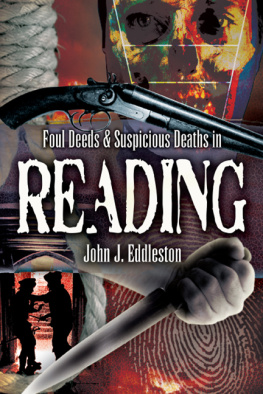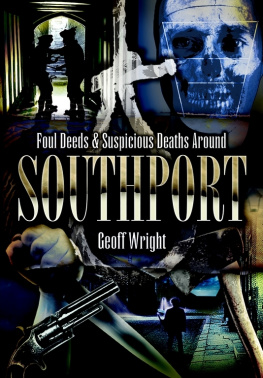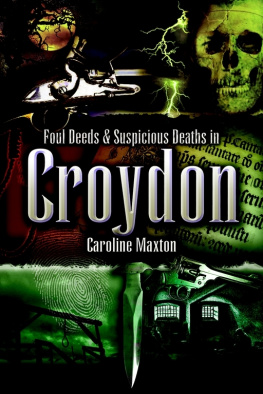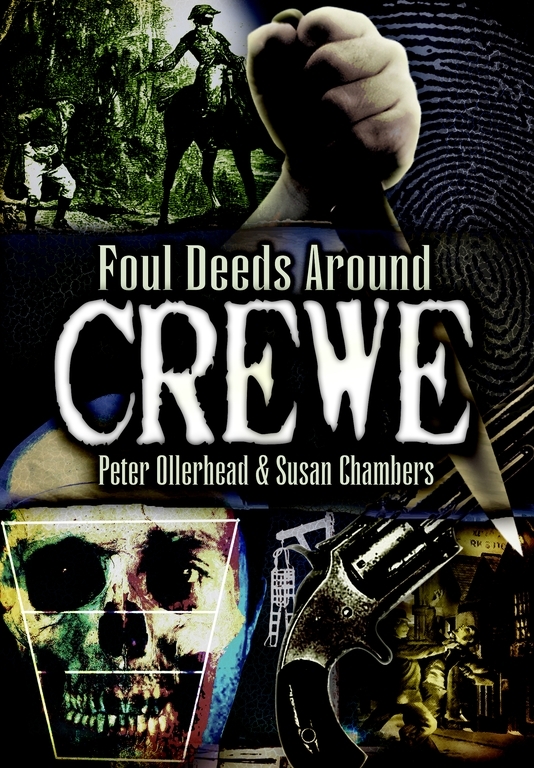References and Acknowledgements
Illustrations
Cheshire Archives and Local Studies (These images reproduced with permission of Cheshire Shared Services and the owner/depositer, to whom copyright is reserved.)
Colin and Mary McLean
Bernard Owen
Woodstock Museum, Canada
Sources
Newspapers
Chester Chronicle
Chester Courant
Crewe Chronicle
Crewe Guardian
The Times
Publications
Booth, P W. The Ride to Justice in Cheshire 1354 , University of Liverpool, 1991
Godfrey, B, Cox, D and Farrall, S. Criminal Lives , Oxford University Press, 2007
Lake, J. The Great Fire of Nantwich , Shiva Publishing Ltd, 1983
Murray, J W. Memoirs of a Great Detective , Heinemann, 1904
Neild, James. The State of the Prisons in England, Scotland and Wales , John Nichols & Son, 1812
Pegler, Revd G. The Waters of Crewe , n.p., 1914
Stevenson, D. Fifty Years of the London & North Western Railway , Kessinger Publishing, reprint 2009
Walton, Sylvia. Middlewich House of Correction , Middlewich Heritage Society Newsletter, March 2009
Yarwood, D. Cheshires Execution Files , Breedon Books, 2007
Records, documents and journals
Cheshire Record Office:
Records of Cheshire Quarter Sessions and Crewe Petty Sessions Consistory Court records
Account of Crockett inquest
Cholmondely Archives
Transportation records
Cheshire volumes of Victoria County History , published by the Institute of Historical Research, London University
Transactions of the Historic Society of Lancashire and Cheshire , Vol. 118, Star Chamber cases
Chetham Society, Calendar of County Court Rolls of Chester 1259 1297
Census returns, 1871 1901
Archives of the Church of Latter-Day Saints
The National Archives:
Records of the Court of Star Chamber
Grand Junction Railway Company Board minutes
With thanks to Olly Chambers, the staff of Crewe Reference Library, especially Katherine Bate, and the staff of Cheshire Record Office for all their assistance.
Chapter 1
Early Tales of Murder and Mayhem
T he modern town of Crewe, born with the coming of the railways in the first year of Victorias reign, is a recent development compared to the neighbouring ancient market towns of Middlewich, Nantwich and Sandbach. In a way of life that changed very little for centuries, the people of south-east Cheshire would bring their cheese, pigs, chickens and linen to the bustling markets in these old towns. A few scattered farms and cottages occupied what we now think of as Crewe town. It was in earlier times known as Monks Coppenhall, a township adjacent to the old Crewe manor in the neighbourhood of Crewe Hall. Villages and hamlets were dotted around this part of the flat Cheshire plain where people lived in thatched timber-framed cottages, tending a few animals and growing crops to keep their families. Oak woodlands flourished on the clay of the surrounding countryside, and provided timber as fuel for the salt workings of Nantwich and Middlewich, while good crops of grass meant plenty of milk for Cheshire cheese production.
Crime has always been an inescapable part of life and even in these peaceful Cheshire hamlets there were early glimpses of acts of violence. There is little trace now of the mill pond and mill cottage that once stood near the Valley Brook as it weaved its way through Barthomley, though the area is still rural. A violent killing took place there in 1260 when Richard the miller was brutally stabbed with a sharp weapon and died in his wifes arms. The culprit was a local man, Osbert, who then went on to steal the couples mare. Osbert claimed that he had killed Richard because he had stolen clothes from his house, but the court at Chester sentenced him to hang. In the same year an Acton woman by the name of Ammera was accused of burglary and hanged, as was Nantwich man William Chapelein, a horse thief. After his trial at Chester Chapelein was handed back to the bailiffs from Nantwich, who took up the offer of the loan of the use of the gibbet as the day was nearly over.
In these early days the tranquil rural Cheshire scene was from time to time shattered by gangs whose lawlessness was notorious throughout England. In the late 1300s Cheshire men were frequently making armed raids into Staffordshire and Shropshire, robbing, raping and murdering, then heading back home with the booty. They felt safe in the knowledge that they could not be tried outside the county and that there was a good chance they would be pardoned by the King for crimes committed within Cheshire, which was one of the few counties at that time that was more or less independent of the rest of the country, being a county palatine. A commission during Richard IIs time reported malefactors who wandered about the county to the terror of the inhabitants. Disputes between local factions were common, kinship ties were strong and often gangs comprising followers of leading families, their tenants and friends were involved in fierce battles over land. In fact, the gentry were frequently the perpetrators of many of the crimes committed and there were no nobles resident in Cheshire to maintain some kind of control.
The Sheriff was the countys chief legal official and staff included sarjeants, who had the liberty to behead robbers on the spot if caught in the act. A County Court met eight or nine times a year, and there was also a travelling court held by the Justice of Chester, known as an eyre. These were held annually over one week in the various hundreds with a local jury; the Nantwich session was always the last to be held, on Saturday and Sunday. (Cheshire was divided into seven hundreds, in use for various administrative functions until the nineteenth century.) The majority of cases were offences against the peace, and assaults in 1354 were reported as being committed with sticks, knives, axes, a rake and a fist. William de Crewe was fined because he didnt turn up for the court, contrary to his tenancy agreement.
In 1407 a prominent Coppenhall family was involved when a gang led by Nicholas Parker murdered Justice of the Peace Thomas Malbon from Bradeley Hall, just over the township boundary in Haslington. Few details of the case survive but it is recorded that Parker was outlawed, which meant he lost any protection from the law and had his lands and goods seized by the Crown. This was often the punishment meted out to those who could not be found and brought to court, and was no doubt preferable to the gallows. This was the fate of many who committed not only murder but any felony which included rape, arson and robbery. Cattle stealing was a common offence that could be punishable by hanging, and Lawrence Priestwood, who stole five bullocks in Woolstanwood in 1463, suffered that punishment at Chester. Some Coppenhall men (including another Parker) who were also accused of stealing cattle a few years earlier had managed to persuade the jury that they were not guilty.
From 1536 Cheshire was obliged to have Crown-appointed Justices of the Peace in Quarter Sessions; in addition to their judicial duties, their powers included preliminary hearings of more serious cases for the assizes and the administration of local government. Cheshire miscreants were tried in Quarter Session Courts held in different towns around the county Chester, Northwich, Middlewich, Knutsford and Nantwich.
Day-to-day guardianship of local affairs was in the hands of township constables, the most important of the township officials who were chosen at the local Manor Courts and every man was supposed to take his turn at this. The constable was expected to maintain the stocks, pillory and whipping post for punishments and the local butts for archery practice in case of invasion and generally do his best to maintain law and order. Every town and village had to have its pillory or stocks for punishing relatively minor incidents and had to report to the Quarter Sessions every year that these were in good repair. In 1603 it was decreed that In every township a whipping stocke is to be set up before the next meeting of her majestys justices. It was also stipulated that vagrants were to be stripped naked from the waist up for whipping (rather than totally naked as previously).

